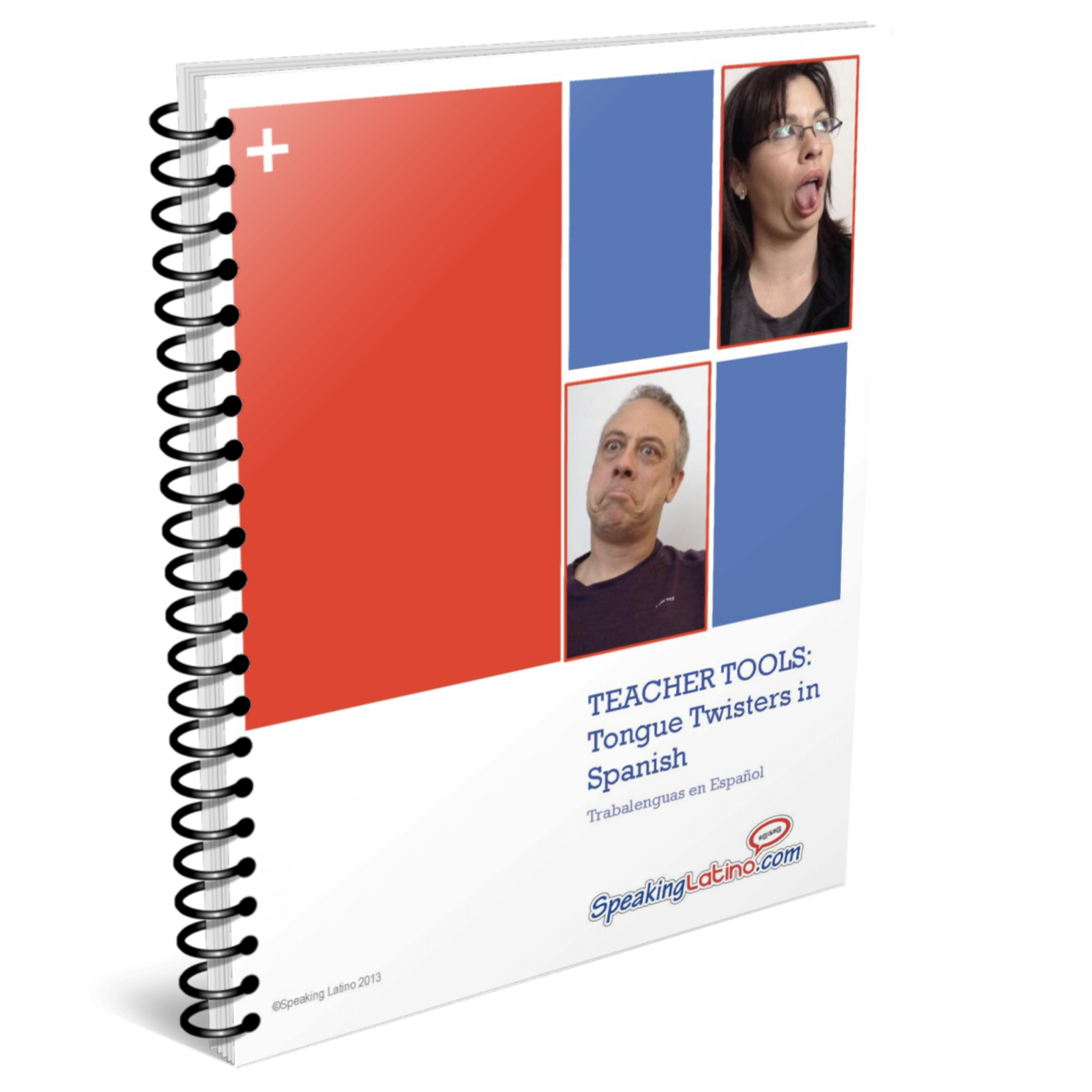
Tongue twisters or trabalenguas are phrases that use repetitive sounds to help you learn Spanish. Those repetitive sounds make them tricky to pronounce at first but when practiced can improve your Spanish pronunciation significantly. Plus it’s one of the most fun ways to practice Spanish!
Whether you are looking for simple Spanish tongue twisters for kids or more advanced trabalenguas for adult learners, there’s just the right tongue twister here for anyone.
In this article you will find out why Spanish tongue twisters are so useful for learning Spanish. And if you are a Spanish teacher, there will even be ideas for what you can do with your students
You will also find tongue twisters for novice to advanced students and even specific tongue twisters to practice certain parts of Spanish, like rolling your RRs.
Many of these are famous Spanish tongue twisters, known throughout the Spanish speaking world however there are others here that are specific to certain countries or regions.
Why Spanish Tongue Twisters Are Great To Learn (And Teach) Spanish
Experts agree that tongue twisters:
5 Tips to learn Spanish while you practice tongue twisters
I’ve put together a few tips to keep in mind as you work through these tongue twisters. These will help you keep from getting tongue-tied and at the same time help you get the most benefit from learning the tongue twisters.
- 1Go slow! There’s no need to go through these at full speed when you start with each one. Take your time to read through them a couple times and as your mouth becomes more comfortable with the sounds, speed up to normal or even faster than normal speed.
- 2No translation! Some tongue twisters don’t make any sense so translating them is impossible. And besides, if you want to become fluent in Spanish, one of the keys is to avoid translating from Spanish to English.
- 3Even native speakers mess these up, so no need to pressure yourself.
- 4Many of these are invented words so translations may not exist. There’s also no need to learn their meanings. Focus on the sounds only.
- 5Have fun! Laugh at yourself. Enjoy these. They’re silly, clever, funny and some are even really tricky. Practicing these are guaranteed to keep you giggling, happy and motivated to learn Spanish.
Spanish Tongue Twisters To Practice Specific Letters And Sounds
One of the most common reasons people look for tongue-twisters is to practice specific letters and sounds that they find challenging. Some of those common yet challenging sounds in Spanish are rolling the R and RRs, as well as letter combinations of TR, BL, CL and CH. Fortunately there’s at least one tongue twister here to practice each.
Spanish tongue twisters to roll your Rs and RRs
One of the biggest challenges for students learning Spanish pronunciation is properly rolling your Rs and RRs.
Before we get to our first tongue twister here are a couple tips I offer to improve how you roll your Rs:
- 1When the R is between two vowels, such as the word aro, think of the R as making more of a D sound where your tongue touches the upper inside part of your teeth, just like in the English word edi-ble.
- 2Repeat the same two-letter sound over, and over, and over, and over to improve your pronunciation. For example take the TR combination in triste and just repeat tr, tr, tr, tr, tr... until you feel more comfortable with how it feels on your tongue. Then tackle a combination of sounds, like tris-, tris-, tris- or even the whole word triste, triste, triste.
- 3PRO TIP: If you have problems pronouncing your Rs and double Rs, some Spanish dialects, for example the Puerto Rican dialect used in the southern part of the island, simply pronounce the R / RR as an English H sound, as in Happy. (the J sound in Spanish, for example, jota). So no need to worry how you pronounce the R. Simply do the H sound!!
One of the best tongue twisters to improve your double Rs is Tres tristes tigres (Three sad tigers) that I guarantee will help you roll your R’s in Spanish. Here are 3 versions of Tres Tristes Tigres:
Spanish tongue twisters: TRES TRISTES TIGRES
- Version 1:
Tres tristes tigres tragaban trigo en un trigal en tres tristes trastos.
En tres tristes trastos tragaban trigo tres tristes tigres.
- Version 2:
Tres tristes tigres triscaban trigo en un trigal.
Un tigre, dos tigres, tres tigres trigaban en un trigal.
¿Qué tigre trigaba más? Todos trigaban igual.
- Version 3:
En tres tristes trastos de trigo, tres tristes tigres comían trigo.
Comían trigo, tres tristes tigres, en tres tristes trastos de trigo.
These next tongue twisters are especially useful to get your Spanish tongue roll R flowing. Half the words in these tongue twisters include the RR for you to practice.
Spanish tongue twisters: ERRE CON ERRE
- Version 1:
Erre con erre cigarro, erre con erre barril.
Rápido corren los carros, cargados de azúcar del ferrocarril.
- Version 2:
Erre con erre cigarro, erre con erre barril.
Rápido corren los carros, detrás del ferrocarril.
- Version 3:
Erre con erre guitarra, erre con erre barril.
Mira que rápido ruedan, las ruedas del ferrocarril.
As you may have noticed, two of the three above versions mention the word ferrocarril. Since it offers double practice for the RRs in only one word, this trabalengua is also known as the Spanish tongue twister Ferrocarril.
Spanish tongue twister with P
Spanish tongue twisters EL PERRO
El perro perra encontró pera,
pero perro perra peras no come,
en cambio perra perro peros no encontró
para comerse la pera que perro perra dejó
Spanish tongue twisters with E
Spanish Tongue Twister CUANDO CUENTES CUENTOS
Cuando cuentes cuentos, cuenta cuantos cuentos cuentas, cuando cuentes cuentos
Spanish Tongue Twister HOY YA ES AYER
Hoy ya es ayer y ayer ya es hoy,
ya llegó el día, y hoy es hoy.
Spanish Tongue Twisters to Practice Vowels
In these next two rhymes, besides lots of Spanish vowel practice, these are great tongue twisters with the letter P too.
Because they are both short, yet offer a wide range of sounds to practice, they are great for teachers to use in the classroom as well as for anyone to practice on their own, as they go about their day.
Spanish Tongue Twister POCO COCO
Como poco coco como,
poco coco compro.
Spanish Tongue Twister SI SANSÓN
Si Sansón no sazona su salsa con sal, sosa le sale la salsa sin sazonar a Sansón.
Spanish Tongue Twister PEPE PECAS
Pepe Pecas pica papas con un pico, con un pico pica papas Pepe Pecas.
Si Pepe Pecas pica papas con un pico, ¿dónde está el pico con pepe pecas pica papas?
Short Spanish Tongue Twisters
These are some of the shortest, most popular Spanish tongue twisters you will run across. The first one, Pancha plancha, is one of the easiest trabalenguas that exists. Pancha is the nickname for Francisca and plancha means an iron.
Easy Spanish Tongue Twisters for Beginners: PANCHA PLANCHA
Pancha plancha con cuatro planchas. ¿Con cuántas planchas Pancha plancha?
Yep, that’s really all it is!
Here’s another short one. It’s a tongue twister for diminutives (those generally add -ito or -ita to the end of a word) Pablito is the diminutive for Pablo, and clavito for a construction nail. Calva means bald patch. Don’t be fooled by this short one, it is a tricky tongue twister.
Spanish Tongue Twister: PABLITO CLAVÓ UN CLAVITO
Pablito clavó un clavito en la calva de un calvito. En la calva de un calvito un clavito clavó Pablito.
Spanish tongue Twister JUAN JUNTA
Juan junta juncos junto a la zanja
Hard Spanish Tongue Twisters
Spanish Tongue Twister: PARANGARICUTIRIMICUARO
El pueblo de Parangaricutirimicuaro se va a desparangaricutirimicuarizar.
Quien logre desparangaricutirimicuarizarlo gran desparangaricutirimicuarizador será.
This next one, Me han dicho que has dicho un dicho, plays with the word dicho, which has two separate, yet related meanings in the tongue twister. One meaning is a conjugation of the verb decir and the other meaning is the word for “a saying.”
Spanish Tongue Twister: ME HAN DICHO QUE HAS DICHO UN DICHO
- Version 1:
Me han dicho que has dicho un dicho, un dicho que he dicho yo.
Ese dicho que te han dicho que yo he dicho, no lo he dicho;
y si yo lo hubiera dicho, estaría muy bien dicho por haberlo dicho yo.
- Version 2:
Me han dicho que has dicho un dicho, que han dicho que he dicho yo.
El que lo ha dicho mintió; y en caso que hubiese dicho ese dicho que han dicho que he dicho yo, dicho y redicho quedó,
y estará bien dicho ese dicho, que han dicho que he dicho yo.
This next tongue twister is famous because it uses the famous opera melody of La donna è mobile (Woman is Fickle) from the opera Rigoletto. In this case all the endings of the nouns and adjectives are substituted with ívida, évido, and ávido changing all the words from llanas to esdrújulas (basically adding more syllables) to perfectly fit the melody. Even though all these word endings are not correct Spanish, you should be able to understand the real meanings.
Spanish Tongue Twister: DOÑA PANCHÍVIDA
Doña Panchívida se cortó un dévido con el cuchívido del zapatévido.
Y su marívido se puso brávido porque el cuchívido estaba afilávido.
Correctly written, the Doña Panchívida tongue twister would be:
Doña Pancha se cortó un dedo con el cuchillo del zapatero.
Y su marido se puso bravo porque el cuchillo estaba afilado.
And now, the hardest, most challenging, difficult Spanish tongue twister ever: El Cielo Está..
In my opinion, the following is the most difficult Spanish tongue twister, even for native Spanish speakers. This one is challenging because the key word does not exist in Spanish. It’s a made-up word.
There are also a lot of variations. You decide which one is the most difficult. Encancaranublado, parangaricutirimicuarizado, engarabintintangulado, encuadriculado, and emborregado are total inventions that in this context mean an overcast sky. The one I learned is the first one.
Spanish Tongue Twister: EL CIELO ESTÁ…
- Version 1:
El cielo está encancaranublado,
Quién lo encancaranublaría?
El que lo encancaranubló,
buen encacaranublador sería.
- Version 2:
El cielo está emborregado,
¿quién lo desemborregará?
El desemborregador que lo desemborregue,
buen desemborregador será.
- Version 3:
El cielo está engarabintintangulado
el que lo desengarabintintangulare
buen desengarabintintangulador será.
- Version 4:
El cielo está emperejilacristalado,
¿Quién lo desemperejilacristalará?
El desemperejilacristalarador que lo desemperejilacristalare,
buen desemperejilacristalarador será.
- Version 5:
El cielo está enladrillado,
¿Quién lo desenladrillará?
El desenladrillador que lo desenladrille,
buen desenladrillador será.
- Version 6:
El cielo esta parangaricutirimicuarizado.
¿Quién lo desparangaricutirimicuarizara?
El desparangaricutirimicuarizador que lo desparangaricutirimicuarize,
buen desparangaricutirimicuarizador será.
Version 7:
El suelo esta encuadriculado.
¿Quién lo desencuadriculará?
El desencuadriculador que lo desencuadriculó,
buen desencuadriculador será.
Finally, one of the keys to successfully learning Spanish with these tongue twisters is your tongue placement. As you work through each slowly, notice where your tongue is located when you pronounce each sound.
As you continue to practice, these tongue positions will become more comfortable for you to use. And with that, you’ll begin to notice your Spanish pronunciation improving!!
Free printable spanish tongue twisters PDF and VIDEOS

We put together a free, printable download for Spanish teachers and students alike, that includes: